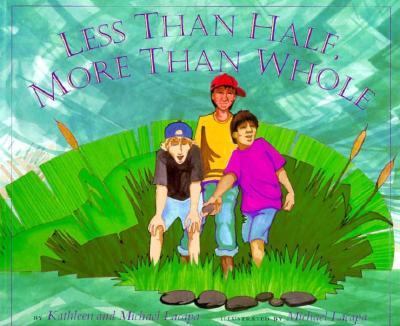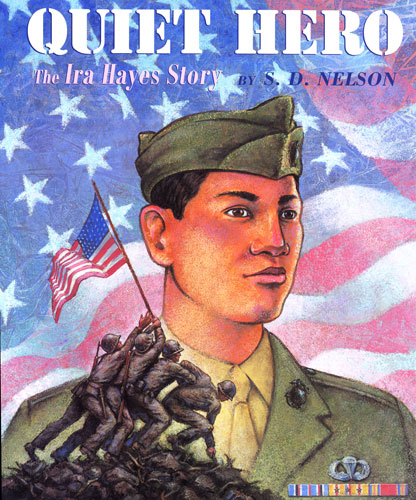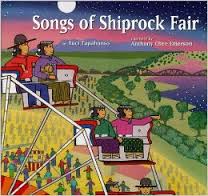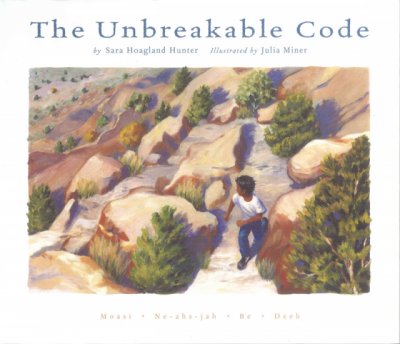American Indians of the Southwest/Hopi and Navajo Language and Culture Kit
Apache Children and Elders Talk Together. Kavasch, E. Barrie. Powerkids Press, 1999. ISBN: 9780823952250.
This book explores the culture and traditions of the Apache people through the voices of Apache children and their elders.
Apache Rodeo. Hoyt-Goldsmith, Diane. Lawrence Migdale, Ill. Holiday House, 1995. ISBN: 9780823411641.
An account of the life of 11-year-old Felicita, a White Mountain Apache girl who lives with her family in Whiteriver, Arizona on the Fort Apache reservation. Felicitia participates in traditional tribal customs such as gathering acorns for making Apache stew and listening to legends, but also collects basketball cards and watches T.V. This book focuses on Felicita’s participation in a rodeo where she competes in the barrel racing, calf-riding, and goat-tying events.
Big Moon Tortilla. Cowley, Joy. Dyanne Strongbow, Ill. Boyds Mills Press, 2002. ISBN: 9781590780374.
A contemporary Tohono O’odham child gets help from an old story. Marta Enos’ day is ruined when the wind blows her papers out the window and the dogs chew her homework; then she trips and breaks her glasses. Grandmother comforts her, repairs the glasses, bakes her warm tortillas, and tells her a traditional tale about how to deal with a problem. Sometimes it is good to be a tree and look all ways at once; sometimes it is best to be a rock or a fierce mountain lion; but Marta Enos chooses to be an eagle, who can fly high and see how small the problem is.
A Boy Named Beckoning: The True Story of Dr. Carlos Montezuma, Native American Hero. Capaldi, Gina. Minneapolis MN: Carolrhoda Books, 2008. ISBN: 9780822576440.
Dr. Carlos Montezuma engaged in long-term advocacy work for the rights of Native Americans in the United States. Born in 1866 to a Yavapai family and named Wassaja, which means, “beckoning,” was captured as a five-year-old boy eventually ending up with Carlo Gentile, an Italian photographer. Much of the book relates their experiences traveling across America and their subsequent settling in Chicago. Inspiring and remarkable events in Montezuma’s life are told through the book’s narrative (which is based largely on a five-page letter written by Montezuma), sidebar facts underneath original photographs taken by Carlo Gentile, and a detailed afterword about Montezuma’s advocacy efforts. The book is also a treasure chest of economics lessons about investing in human resources, the economics of education, jobs, work, discrimination, and land rights.
Children of Clay: A Family of Pueblo Potters. Swentzell, Rina. Bill Steen, Ill. First Avenue Editions, 1993. ISBN: 9780822596271.
Members of a Tewa Indian family living in Santa Clara Pueblo in New Mexico follow the ages-old traditions of their people as they create various objects of clay. The book follows Gia Rose as she and her relatives drive to the mountains to dig for clay; prepare it for working; and fashion pieces that are then polished, sanded, and fired.

Code Talker: A Novel about the Navajo Marines of World War Two. Bruchac, Joseph. Dial, 2005. ISBN: 9780803729216.
Throughout World War II, in the conflict fought against Japan, Navajo code talkers were a crucial part of the U.S. effort, sending messages back and forth in an unbreakable code that used their native language. They braved some of the heaviest fighting of the war, and with their code, they saved countless American lives. Yet their story remained classified for more than twenty years. But now Joseph Bruchac brings their stories to life for young adults through the riveting fictional tale of Ned Begay, a sixteen-year-old Navajo boy who becomes a code talker. His grueling journey is eye-opening and inspiring. This deeply affecting novel honors all of those young men, like Ned, who dared to serve, and it honors the culture and language of the Navajo Indians.
Cowboy Up!: Ride the Navajo Rodeo. Flood, Nancy Bo. Sonnenmair, Jan, Ill. WordSong, 2013. ISBN: 9781590788936.
It’s morning at the rodeo. Riders are standing by. Horses are in the chutes. “Cowboy up!” the announcer calls. Then the excitement begins in this riveting collection, narrative poems give voice to the individual competitors, lively prose explains rodeo events, and evocative photographs show off the riders and ropers, the horses, bulls, and broncs. It all adds up to an unforgettable close-up view of Navajo rodeo over the course of one action-packed day.
Coyote and the Sky: How the Sun, Moon, and Stars Began. Garcia, Emmett. Victoria Pringle, Ill. University of New Mexico Press, 2006. ISBN: 9780826337306.
According to Santa Ana Pueblo legend, the animals’ spirit Leader created the sun, moon, and stars by using woven yucca mats and hot coals. He selected certain animals to climb from their homes in the Third World up to the Fourth World. The Squirrel, the Rabbit, and the Badger were all allowed to go. The Coyote, however, was forbidden to accompany them because he was always causing trouble and stealing food from the others. Coyote refused to stay in the Third World and waited for a chance to follow the animals to the Fourth World. When the other animals discovered Coyote, they summoned the Leader to the Fourth World to deal with him. Coyote’s punishment is a lesson in what happens to animals, or people, when they refuse to obey instructions.
Dzani Yazhi Naazbaa’ / Little Woman Warrior Who Came Home: A Story of the Navajo Long Walk. Parsons-Yazzie. Irving Toddy, Ill. Flagstaff, AZ: Salina Bookshelf, 2005. ISBN: 9781893354555.
Dzanibaa’ is alone when U.S. troops swoop down on her family’s hogan. She is taken to Fort Canby, and from there is forced to walk to Bosque Redondo. For four long years, Dzanibaa’ and her family endure incredible hardship and sacrifice. Crops wither. Food is scarce or so tainted that it poisons. Illness strikes. This time of trial gives Dzanibaa’ a profound sense of herself as a Navajo and of the importance of her culture. As never before, Dzanibaa’ realizes the significance of the clan system, of the prayers and songs of her people, and of exerting herself to help her family.
Field Mouse Goes to War/Tusan Homichi Tuwvota: A Bilingual Hopi Tale. Kennard, Edward & Beatty, Willard. Fred Kabotie, Ill. Filter Press, 1977. ISBN: 0910584478.
This traditional Hopi tale recounts the courage and cleverness of a tiny field mouse striving to protect the village from a mighty hawk that is stealing the chickens. Originally published by the Bureau of Indian Affairs, the drawings are by Hopi artist Fred Kabotie who was commissioned by the Museum of the American Indian in New York to record authentic native dances and by the Fred Harvey Company to decorate the Indian Tower on the south Rim of the Grand Canyon. The book is in English and phonetic Hopi with a pronunciation guide.
The Fire Stealers: A Hopi Story. Lomatuway’Ma, Michael and Malotki, Ekkehart. Ken Gary, Ill. Kiva Publishing Inc., 2003. ISBN: 9781885772138.
This traditional Hopi story is set in a mythic time when people and animals were still able to communicate and interact with each other. By emphasizing the dependence of humans on animals, the story affirms the vital connections among all living species. Illustrator Ken Gary was inspired by ancient Pueblo kiva murals, especially those at Pottery Mound in New Mexico and Awat’ovi and Kawaika-a in Arizona. The illustrations are reminiscent of the highly stylized, geometric, two-dimensional mythological motifs of these murals.

The Flute Player: An Apache Folk Tale. Lacapa, Michael. Cooper Square, 1990. ISBN: 9780873585002.
This Apache pourquoi folktale explains that the sound of wind echoing through the canyons comes from the flute of a young brave serenading his sweetheart. When the young man goes on his first hunt without telling her, she is sure she’s been forgotten and becomes ill and dies. Returning home, the boy learns of her death, and continues to play his flute at her grave. The large, full-page, boldly colored drawings are filled with dramatic, abstract shapes and earth colors.
The Gift of Changing Woman. Seymour, Tryntje Van Ness. Henry Holt, 1993. ISBN: 9780805025774.
When Apache girls reach puberty, their families hold the Na’ii’ees, or
the Changing Woman Ceremony, which welcomes them to womanhood. Beginning with
a brief account of the story of Changing Woman, the author describes the celebration, interjecting comments and reminiscences by Apaches. Full-color reproductions of
paintings by 10 different Apache artists depict parts of the Na’ii’ees gathered from
museums around the country, spanning over 100 years. The background and source notes stand as a benchmark for comparison.
Kinaalda: A Navajo Girl Grows Up. Roessel, Monty. First Avenue Editions, 1993. ISBN: 9780822596417.
Celinda McKelvey, a Navajo girl, participates in the Kinaalda, the traditional coming of age ceremony of her people. The ceremony is composed of two days of prayer, ritual, feasting, running, and rejoicing. The text describes the ceremony and relates the ancient story that gave rise to it.

Less Than Half, More Than Whole. Lacapa, Kathleen. Michael Lacapa, Ill. Northland Pub, 1999. ISBN: 9780873587341.
Tony notices that his skin is darker than yellow-haired, blue-eyed Scott’s, but lighter than that of his Native American friend, Will. Will’s explanation that Tony is half or “less than half” of each culture does not satisfy him. Questioning his aunt, his brother and sister, and his uncle, he strives to understand his heritage. Each person offers him a wise answer, but it is his Native American grandfather who helps him see that Tony reflects all the colors of his family, and is “more than whole.” Based in the experiences of the author and illustrator who are Irish American and Hopi/Tewa/Apache.
The Magic Hummingbird: A Hopi Folktale. Lomatuway’Ma, Michael and Malotki, Ekkehart. Michael Lacapa, Ill. Kiva Publishing, 1996. ISBN: 9781885772046.
In this Hopi traditional story, two young children are left behind in the drought-stricken village of Oraibi. A sunflower stalk fashioned into the shape of a hummingbird magically springs to life to supply them with corn. The magical bird then journeys to the underworld to ask Muy’ingwa, the god of fertility, to restore precious rainfall to the land. The book focuses on the world of the Hopi, where the way of life is based on harmony of the elements, such as sunshine and rainfall for the growth of crops. The story emphasizes the importance of staying in contact with the source of creation.
Ma’ii and Cousin Horned Toad: A Traditional Navajo Story. Begay, Shonto. Scholastic, 1992. ISBN: 0590453904.
A retelling of a traditional Navajo tale introduces young readers to Ma’ii, the coyote known to the Navajo as a mischief-maker, and his wise counterpart, the Horned Toad. Coyote loves to eat and will do almost anything for a free lunch.
Meet Mindy: A Native Girl from the Southwest. Secakuku, Susan. John Harrington, Ill. Council Oak Books, 2006. ISBN: 9781582700915
“Loloma. My name is Mindy, and I’m fourteen. My Hopi name is Dawayumsi, which means ‘new dawn’ or ‘beginning of a new day.'” This book tells the story of Mindy, a Hopi and Tewa girl. John Harrington’s impressive photography brings to life the Arizona landscape and the beautiful katchina dolls carved by Mindy’s father and grandfather. Susan Secakuku of the Hopi Butterfly Clan relates in detail the ceremonies that are special to the Hopi, such as the Corn Grinding Ceremony. She shows what daily life is like today, high on the mesas of Arizona.
Monster Slayer: A Navajo Folktale. Browne, Vee. Whitethorne, Baje, Ill. Northland Publishing, 1991. ISBN: 9780873585255.
A terrible monster is plaguing the Anasazi villages of the Southwest’s canyon country, so much so that the villagers are afraid to plant their crops. Who will save them from the monster’s wrath? The Twins, twelve-year-old sons of Changing Woman, respond to the villagers’ cries for help.
The Mouse Couple: A Hopi Folktale. Malotki, Ekkehart. Michael Lacapa, Ill. Northland Publishing, 1988. ISBN: 9780873584739.
A mouse couple, in search of the mightiest husband for their daughter, approach the sun, the clouds, the wind, and a butte, before the unexpected victor finally appears.
Navajo: Visions and Voices Across the Mesa. Begay, Shonto. Scholastic, 1995. ISBN 9780590461542.
The poems and illustrations provide a range of reflections on Navajo life, including creation stories, childhood memories, tribal rituals, and the profound effect of white people on Navajo land and culture. A renowned Navajo artist/writer combines the best of his paintings with his rich poetic voice to give young readers an insightful glimpse into the lives and souls of his people.
Ocean Power: Poems from the Desert (Sun Tracks: An American Indian Literary). Zepeda, Ofelia. Tucson, AZ: University of Arizona Press, 1995. ISBN: 9780816515417.
The annual seasons and rhythms of the desert are a dance of clouds, wind, rain, and and
flood. The critical importance of weather and climate to native desert peoples is
reflected in this collection of poems. Ofelia Zepeda centers these poems on her own
experiences growing up in a Tohono O’odham family, where desert climate profoundly
influences daily life, and on her perceptions as a contemporary Tohono O’odham
woman. One section of poems deals with contemporary life, personal history, and the
meeting of old and new ways. Another section deals with winter and human responses to light and air. The final group of poems focuses on the nature of women, the ocean, and the way the past relationship of the O’odham with the ocean may still inform present day experience.

Quiet Hero: The Ira Hayes Story. Nelson, S.D. Lee & Low Books, 2009. ISBN: 9781600604270.
Growing up on the Gila River Indian Reservation in Arizona, Ira Hayes was a quiet, shy boy. He never wanted to be the center of attention, and at school, he felt lonely and out of place. During World War II, Ira joined the Marine Corps. He believed it was his duty to fight honorably for his country, and with his Marine buddies, Ira finally felt as if he belonged. Eventually they were sent to the tiny Japanese island of Iwo Jima, where a chance event and an extraordinary photograph catapulted Ira to national awareness and transformed his life forever. Quiet Hero is the story of one person’s courage in the face of both military and personal battles.
Racing the Sun. Pitts, Paul. HarperCollins, 1988. ISBN: 9780380754960.
Being an American Indian wasn’t something twelve-year-old Brandon Rogers liked to advertise. His father had left his Navajo heritage behind when he went to college and Brandon had grown up in suburbia-just a regular kid. But then Brandon’s Navajo grandfather moved off the reservation and into the lower bunk in Brandon’s room. It wasn’t easy having a roommate who chanted himself to sleep and got you out of bed before sunrise to race the sun. Brandon learns lessons about how to take on the old ways without giving up the new and how to grow up proud and strong … with a heritage as real as an old man’s love.
A Rainbow at Night: The World in Words and Pictures by Navajo Children. Hucks, Bruce. Chronicle Books, 1996. ISBN: 9780811812948.
The children’s imaginative paintings and drawings introduce readers to their world. Through their eyes readers will learn about some of the special traditions of Navajo life while discovering the universality shared by children of all backgrounds. Photographic portraits of the artists and personal descriptions of their work accompany the images. In addition, Bruce Hucko offers further insight into the Navajo culture and suggests art projects relating to each image that invite children of all ages and cultures to get out their art materials and create!
Rattlesnake Mesa: Stories from a Native American Childhood. Weber, EdNah New Rider. Lee & Low Books, 2004. ISBN: 9781584302315.
EdNah New Rider Weber chronicles the stories of her childhood as she is moved from her Pawnee home to live with her father on a Navajo reservation, and then uprooted and placed in the Phoenix Indian School.
Sing Down the Rain. Moreillon, Judi. Michael Chiago, Ill. Kiva Publishing, 1997. ISBN: 9781885772077.
The Tohono O’Odham Indians who live in the Sonoran Desert prepare for the rains necessary to provide fruit for the Saguaro Wine Ceremony, their most important harvest celebration. Illustrated by a Tohono O’odham artist, Michael Chiago.
Songs from the Loom: A Navajo Girl Learns to Weave. Roessel, Monty. Lerner Publishing Group, 1995. ISBN: 0822597128.
Roessel shares his heritage by describing how his mother taught his daughter how to work a loom. From the shearing of the sheep to the weaving itself, traditions, stories, and lively, full-color photographs bring the activities to life. A photo-essay about weaving the Navajo way that reveals information about the culture and way of life of these people.

Songs of Shiprock Fair. Tapahonso, Luci. Anthony Emerson, Ill. Kiva Publishing Inc., 1999. ISBN: 9781885772114.
The Shiprock Fair is held annually in Shiprock, New Mexico. As the oldest fair in the Navajo Nation, it embodies the spirit of the Navajo people–their love of fun and excitement, their heartfelt commitment to family, and their talent and creativity. The Shiprock Fair harmonizes their sense of enjoyment with their deep spirituality. Seen through the eyes of Nezbah, a young girl, the Shiprock Fair is a magical time with family and friends. Luci Tapahonso’s poetry captures the anticipation and exhilaration of Nezbah’s experience, and Anthony Emerson’s illustrations bring the color and excitement of the fair to life.
A Summer’s Trade. Trotter, Deborah W. Irving Toddy, Ill. Salina Bookshelf, 2007. ISBN: 9781893354715.
Tony makes the long drive into Gallup with his mother to work at the local trading post during the summer. He is saving his money to buy a beautiful, dark leather saddle with nuggets of turquoise that he can use to help his father tend the flocks of sheep and goats. Just when Tony has almost enough money, everything goes wrong. Tony’s uncle breaks his foot, the bills become difficult to pay, and Grandmother pawns her precious silver and turquoise bracelet that she has worn since she was a young woman. Then Grandmother becomes ill, and Tony knows he must do something to help out.
Ten Little Rabbits. Grossman, Virginia. Sylvia. Long, Ill. Chronicle Books, 1995. ISBN: 9780811821322.
This counting book goes across many different Native American tribes but the illustrations are problematic and offensive, particularly the focus on counting Indians as objects or “cute” animals. The illustrations trivialize important aspects of Native cultures and perpetuate the stereotype that all Indian people are alike, but just wear different blankets. This book was included in the kit as an example of stereotypes.

The Unbreakable Code. Hunter, Sara Hoagland. Julia Minor, Ill. Rising Moon, 2007. ISBN: 9780873589178.
John’s mother is getting married and he has to leave the reservation. John’s grandfather tells him that he has the special unbreakable code to take with him. This story portrays the quiet pride of a Navajo code talker as he explains to his grandson how the Navajo language, faith and ingenuity helped win World War
Zinnia: How the Corn was Saved. Powell, Patricia Hruby. Kendrick Benally, Ill. Salina Bookshelf, 2009. ISBN: 9781893354388.
When the Navajo’s crops fail yet again, Red Bird is sent to ask Spider Woman for her help. His journey leads him to a flock of sun- yellow birds, a lizard, a Gila monster, and a snake. To each of the animals, Red Bird asks the same question: “Could you tell me where Spider Woman lives?” At last, after traveling in each of the four directions, Red Bird finds Spider Woman sitting in her web.
